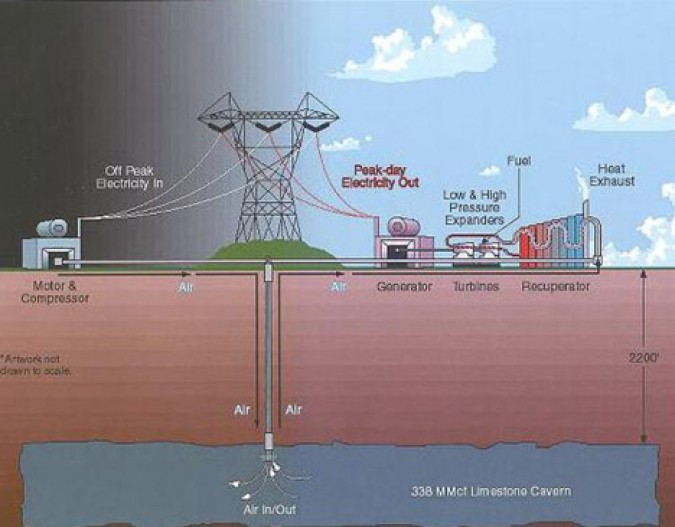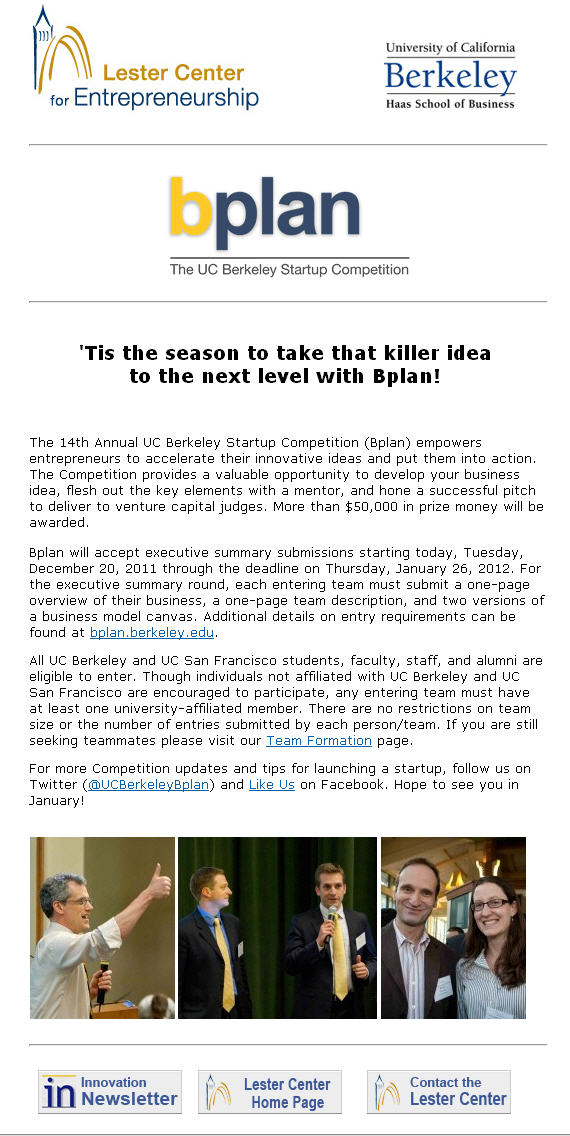Archive for 2011
Store meaningful amounts of electricity in rocks or sand? Engineers, please help me run some numbers.
Today solar and wind plants sometimes provide round the clock output by using daytime power from the sun to pump water up hill to a resevoir, which is then allowed to flow downhill through turbines at night to generate electricity. This takes space and water, which probably makes it unworkable at home. This form of energy storage is called Pumped Hydro Energy Storage.
There is also another storage method called Compressed Air Energy Storage, which works like it sounds — air is compressed with solar energy and the compressed air is used later to run a turbine to generate electricity. I can see that working for industrial scale systems, but for home use I see it as being too noisy, given the racket my Harbor Freight air compressor makes filling an eight gallon tank. I wonder how noisy the residential Honda natural gas compressors are to fill your compressed natural gas Civic automobile in your home garage? I bet they’re not silent.
What I propose is to lift rocks or sand with solar or wind generated electricity. Then, when the sun is down or the wind is calm, lower the rocks or sand back down and have the cable spin a highly geared generator to make electricity. The mechanics of this would seem to be similar to what’s been developed for electric vehicles with their regenerative braking systems. In such systems, a heavy car is brought up to speed at great cost in energy, and when the driver steps on the brakes, that energy is harvested and put back into the on board batteries where the energy was earlier, before the driver stepped on the accelerator. An elevator of weights in the backyard or basement would work similarly, and would be far less complex to design and build than an electric vehicle, I suspect. The most complicated part would probably be figuring out how to pull large irregular amounts of electricity out of the system, to run a hair dryer for a couple of minutes, for example. Since houses draw power almost all the time, the weight would always be in motion, but ever so slowly if the only load was a few electric clocks at night during moderate weather when neither heat or air conditioning is needed.
My friend Jim Castelaz over at the very cool startup Motiv Power Systems has a lot of very smart engineers working on electric power systems for buses, and I suspect any of them could figure out in minutes if this blog post has any merit. I simply don’t know how to calculate how big a weight would be needed to store enough energy to be practical. What I do strongly suspect however is that this is not far fetched. Sure the weight may need to be 100 tons, but so what? That’s not going to dent the earth, and since sand can be used, the weight can be carried in via wheel barrow if needed, by one person.
The big benefit of this is that the efficiency would not decline like with batteries, and such a system could last for decades with proper maintenance, like elevators do in buildings. Also, there are few environmental hazards with such a system. No explosive gasses emitted during ‘charging.’ No chance of explosion. No chance of getting acid burns. No worry if the system freezes. Easy to understand and repair. Easy to manufacture. I love it.
There is also no issue with an idle system losing power just sitting there. So this could also work for backup power for data centers. Seems far easier to engineer than huge concrete flywheels on the roof like I’ve heard about.
Maybe ocean shipping conainers could be used as the energy storage elevator cars. How much would a container with sand weigh, anyway? Would it burst from the load if you tried to lift it by the lifting points? How much trouble would it be to reinforce a container to handle the weight if it were filled with sand?
I love this idea, which I had while falling asleep November 23, 2011 at 1:45am and I wrote up minutes later on my blog so I would not forget it. I finished refining and editing this post today, December 20, 2011, when I made it public to my readers.
It turns out I’m not the first to think of storing electricity via lifting weights. Have a look at this educational piece from a website that describes itself as about primitive Christianity. Here’s a discussion about using weights hanging from an ocean seasteading platform. Here’s an even more thoughtful analysis from someone who also independently thought of doing this. Finally, here is a presentation by Gravity Power Storage which is proposing to build utility scale versions of what I describe here, with 2,000 ton weights storing megawatts. I came up with this idea independently. While I could have discarded this post upon discovering lots of other prior work in this field, as shown by these links, I am publishing it anyway because I am proud to have independently developed this idea, and I think it deserves more attention. It looks like Gravity Power Storage has concluded I am not nuts. Thank you.
The idea of storing energy in heavy weights is so elementary I suspect this idea dates to soon after the harnessing of electricity by man. What I want to know is whether my idea is practical. If it is, why has it not been implemented more widely?
Yes, in much of the United States, the power utilities are required to buy any electricity you make and then sell it back to you when and if you need it. This makes the power company into nearly a perfect battery that sidesteps the energy losses inherent in chemical battery storage.
But what if we could get rid of electricity companies over time? Do we really need to have electricity companies? If we cover the roofs of our homes with solar photovoltaic panels and switch to electric bicycles and live close to our jobs, perhaps there would be no need to import electricity from afar.
Sure, my system as described would cost over USD $10,000, even in quantity. But so does a swimming pool, and there are plenty of those around, with many sitting idle most of the time. A pool also requires a big hole in the ground, so there are lots of hole digging experts around. A pool of water probably weighs 100 tons, so such a huge weight at home has been routinely handled for centuries. The alternators and inverters required by my idea are commodities. Elevator mechanisms are commodities. Tying everything together will take some expertise that needs to be developed, but I don’t see any insurmountable challenges.
Again, a system like I describe will have a long and relatively trouble free life span. Such systems probably can store enough power to last a week provided electricity use is cut to what an off grid solar house uses today. All houses ought to cut down their usage to such levels, even without adding the on site storage component. There are very efficient appliances out there already. Heating can be done with solar hot water collectors. Everything needed has been invented and is already made at scale.
If what I write about is practical, let’s just implement it already. Cheap and efficient electricity storage is a market likely to be worth tens of billions of dollars. This is exciting enough that I could be persuaded to work on this full time. If you’re an engineer, please run some numbers and let me know what you conclude.
Berkeley Startup Competition – please participate
Please participate in the UC Berkeley Startup Competition, formerly known as the UC Berkeley Business Plan Competition. Here’s the email notice I received this morning from the competition organizers. Since this link will eventually not work, I prepared a screen capture of the email and I show it below this paragraph.
My friend Kelly Karns of AutoTB is shown in the picture at the lower right of the email screen capture above. That’s Andre Marquis, the Executive Director of The Lester Center for Entrepreneurship in the lower left. Marquis is shaking things up and making changes — I wrote to him October 5, 2011 suggesting the name of this event be changed to The Berkeley Startup Competition, and today I open my email and the name has been changed. My suggestion may not have been unique, so I am not trying to take all or even a majority of the credit for renaming the premier entrepreneurial competition at Berkeley. But I will take my earned share, however tiny or substantial that turns out to be.
I made the name change suggestion to take the focus off of writing business plans that few will read or pay attention to. Instead, I want the focus to be on creating viable startups that create jobs and change the world. Achieving this goal will require a lot more than a new name, and I hope to be invited to contribute more of my many ideas to help reach this goal.
I was a finalist in this event in 1999 and my success I trace directly to this competition. I am grateful that the rules allowed me to compete. I am grateful the rules still allow me to compete, should I want to start a new company.
I have donated USD $20,000 to the competition since 2000 — I am that grateful.
The Lester Center has extended to me many perks beyond what I technically ‘paid for’ with this $20,000, and I thank them for their extraordinary generosity. For example, I’ve recently concluded a dozen year stint on the Advisory Council of the Berkeley Entrepreneurs Forum. I paid nothing for this membership during this dozen years, despite the Council being a fund raising mechanism for the Lester Center. I enjoyed dozens of fascinating dinners during this period, and I made a lot of smart and interesting friends by my membership, including Jerry Engel, Brian Goncher, Robert Dellenbach, Laura Oliphant, Sam Angus and Tom Kintner and by association his brother Avery Kintner. I will miss these twice yearly dinners, which I never missed unless I was out of California.
I am talking with Marquis to expand and extend my assistance to the competition over the next 14 years. There is so much more I can do to help, and the future looks bright under the stewardship of Andre Marquis and the leadership of the student organizers, who have the responsibility to run and perpetuate the event.
Wood pellet stove installs like a window air conditioner
Last week when I was in Oregon, USA visiting my 100 year old grandmother Elsie Battaglia, I stayed in Eugene for two nights, once on the way to Tigard, Oregon where Battaglia lives, and once on my way back home to my house in San Francisco, California.
I stayed in Eugene for two reasons:
The first reason was that my girlfriend Teanna Keller from when I was about 23 years old was from Eugene, and I have always wondered what that city was like. I worked at Newell Color Laboratory (since closed) back then with Jennifer Viksten, who I’m still in touch with thanks to the wonders of Facebook. I also worked at Newell with Hershel Klein, Bobby Ulloa and Shawn Renee Roberts.
The second reason is I have wanted for some time now to see a Cabela’s store in person. Patrick Nolan, a fellow bus enthusiast, introduced me to the Cabela’s catalog, and I was super intrigued when he showed it to me. The Cabela’s catalog is the old school Sears Catalog of fishing, boating, hunting, shooting and camping equipment.
I knew there was a Cabela’s opening up in Eugene because on my last drive to Tigard, this summer, I saw the billboards advertising the upcoming grand opening. The store is now open and I spent some time looking around.
I was shocked at how many models of hand guns they have on display. There were dozens of hand guns in glass cases, some over USD $1,500. There was a sign by the door advising people to declare their weapons upon entry to the store. Weapons were not prohibited to be carried into the store — Cabela’s just wanted you to tell them about them up front.
The store was big and lush, but its dedication to so many hand guns ruined it for me. I don’t see why hunters need handguns. Even if they do need handguns, do they need dozens of handguns?
One product that really caught my eye I discovered on the Cabela’s website. Have a look at this window mount wood pellet stove. It mounts in a window like an air conditioner. You plug it in to electricity and fill it with 30 pounds of wood pellets and you then can get up to 28,000 BTUs of heat out of it.
This product has the power to change lives, in my mind.
I used to go to Noisebridge, a hacking space in San Francisco somewhat similar to Hacker Dojo in Mountain View, California that I used to be a paid member of in its early days.
Hacker Dojo was too far away for me to visit regularly, and my romantic partner at the time hated me going down there to work because I spent less time with her at home. I investigated Noisebridge, and it showed promise, but the space is unheated. There is no natural gas service to the space, and the space is too large and too poorly insulated to economically heat with electricity. In the winter it’s so cold in Noisebridge you can see your breath and you have to wear a parka and gloves. This made it impossible for me to productively program, so I made other plans.
However, I still love the idea of Noisebridge, and I’m toying with the idea of joining if I can persuade the organizers to heat the space when it’s cold, which could be in the summer given the cool weather San Francisco is known for.
This pellet heater is portable and requires no chimney. That makes me believe that it may be installed just when needed, and without a building permit. I can see it might be impossible to get a permit at Noisebridge to install a fixed wood burning stove, as I rarely see wood stoves in commercial spaces.
At 28,000 BTUs, it would probably only take one or two of these stoves to fully heat the space, perhaps one at each end, where the windows are. Pellets can be delivered in truck load quantities for prices that are much lower than it would cost in electricity to produce comparable heat through resistance heating.
Noisebridge has a large freight elevator and lots of space, so taking deliveries of even tons of pellets would be practical. Their membership should increase if the space is kept warm and inviting. The increased membership fees will pay for a heater or two plus the pellets to feed them. The electricity this heater requires is to run the automated feed mechanism, a trivial amount of power. I understand their lease prohibits space heaters, but I suspect this window mount unit is not legally a ‘space heater.’ Since it’s mounted and secured in a window opening, it can’t be accidentally tipped over, and since it’s not at floor level, it’s more protected than a space heater would be.
I am hopeful Noisebridge will warm up to installing these heaters.
Warren Hellman dies at age 77

Warren Hellman dies at age 77. This is a screen shot from the front page of the San Francisco Chronicle website sfgate.com on December 18, 2011.
Warren Hellman has passed away. He was 77 years young.
Here is a PDF file of the nice article from today’s San Francisco Chronicle newspaper – Warren Hellman dies at age 77. Article from San Francisco Chronicle newspaper, December 18, 2011.
Here’s the link to the article itself. Please read the article at the SFgate website and only access the PDF file if the SFgate link goes dead in the future.
I met Hellman in 2006 when he won the Lester Center for Entrepreneurship Lifetime Achievement Award.
My readers will recognize the Lester Center, for I have been attending its events regularly almost since its inception 20 years ago by my friend Jerry Engel, Senior Fellow and Executive Director Emeritus of the Lester Center for Entrepreneurship. The Lester Center for Entrepreneurship was founded in 1991 through a gift from W. Howard Lester, Chairman of Williams-Sonoma, Inc.
Hellman received his lifetime achievement award from the Lester Center at a gathering of the Berkeley Entrepreneurs Forum, one of the many events produced by the Lester Center.
Here’s a screen capture from the hf.com website of Hellman and Friedman LLC, which shows Hellman’s bio and photograph.
Sadly, I don’t recall any details from the Berkeley Entrepreneurs Forum where I met Hellman, as that was half a decade ago.
Elsie Battaglia’s 100th birthday party at The Original Pancake House in Portland, Oregon
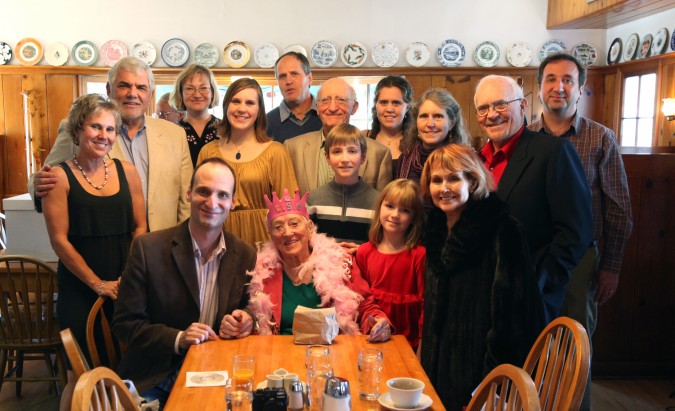
Elsie Battaglia's 100th birthday party at The Original Pancake House, 8601 SW 24th Avenue, Portland, Oregon, USA, December 12, 2011
This morning my young at heart grandmother Elsie Battaglia celebrated her 100th birthday party. She was born on this day in 1911! Seventy five of her friends and family joined her at The Original Pancake House. Battaglia has been friends with the proprietors of this business since 1950.
In the photo above, I’m sitting to the left of my grandmother.
I encountered a very unusual used vehicle salesman – Reza Fotoohi of Royal Motor in San Leandro, California
One of the projects I’ve been toying with requires that I own a box truck. I have shelved the project for now, but when I was investigating this project, I had the good fortune to meet Reza Fotoohi, the owner of Royal Motor. Royal Motor is located at 16575 East 14th Street in San Leandro, California, USA.
Fotoohi stands apart from every other used vehicle salesperson I have ever encountered in life, and I’ve met a lot because I’ve only bought used vehicles because I believe that’s the most sound financial way to buy a vehicle.
Fotoohi has a LOT of used trucks for sale. He had a second lot he had to drive me to filled with perhaps 100 trucks, from really old to almost new and from small to huge. He had three trucks that could have been suitable for my off beat project. I liked all of them very much. I dreamed about them for days.
I described my project to Fottohi in great detail, sharing my plans and my vision. He was an astute and careful thinker and conversationalist, I found. We spent perhaps two hours together, talking and measuring trucks and evaluating their suitability. Any of the three trucks would have been suitable for my project.
I am writing this post because Reza Fotoohi advised me to pass on all of his trucks and to keep looking for even a better fit. He took my card and promised to call me when he had a more suitable truck in stock. I took his card.
Fotoohi started this business in 1984, and you can tell it’s his passion and life’s work. He was proud of his expertise and inventory.
You can be certain that when my project gets back on the front burner that my first stop will be at Royal Motor. You can’t help but think highly of Fotoohi for putting my project coming out well ahead of his making a sale right now. I have no idea if his trucks are good or bad, but with this uncommon display of ethics, I suspect his trucks are worth what he charges. I found Royal Motor on Craigslist, which Fotoohi’s a huge fan of. He advertises exclusively on Craigslist now, and was able to cut his advertising expenditures of USD $30,000 per year by canceling his contracts with websites that charged for listings. That’s money going right into Fotoohi’s pocket I suspect, and Craig Newmark, Jim Buckmaster and their team at Craigslist should be so proud that their website allows such beneficial outcomes on a world scale.
If you need a used truck, please visit Royal Motor and tell Mr. Fotoohi that I sent you.
A small way the world wastes big money can be fixed by super sizing our plumbing. Switch to toilet sized drain pipe for all drains.
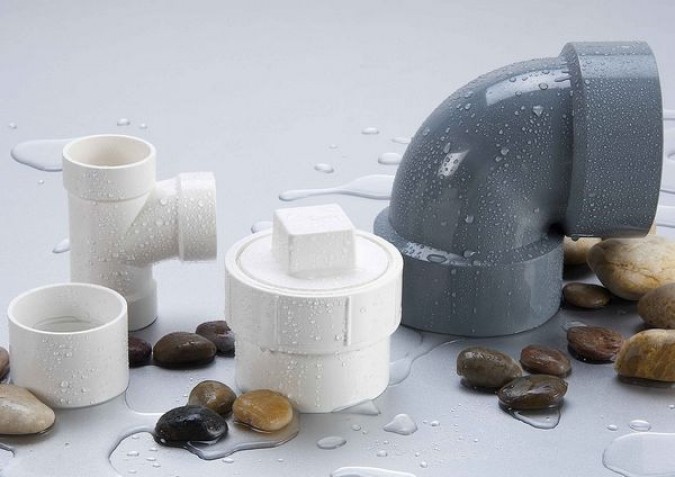
1.5" diameter drain fitting on the left and a 4" diameter drain pipe fitting on the right. Photo from http://scorevalve.com/
On January 27, 2011 I wrote a post suggesting people could live a more comfortable retirement if they stopped frittering away their money by buying necessities in quantities far smaller than made sense. The example I used was dental floss. We all need it, but we typically buy it in tiny little packages that we have to keep buying every couple of months forever.
This is stupid.
It would be far better to buy a roll of dental floss the size of a softball and have it last for a decade. Think about how many plastic containers for dental floss you’ve thrown out over the years and multiply that number by billions. That’s a lot of plastic containers.
Another product the world almost universally buys in too small a size is waste water pipe.
In the United States and all the other countries I’ve visited, the diameter of the drain pipes under the sinks, bathtubs and showers is about 1.5 inches. This is too small for our own good. Because of this small size, there is a section in every grocery and hardware store that I know of where I can purchase caustic chemicals that I am instructed to pour down the drain and into our water supply. Think of the huge tanker trucks of this drain ‘cleaner’ just slobbering their contents into our water treatments plants every day of the year. Yuck!
We buy these nasty products that will burn out your esophogous if you drink it because building codes call for drainage pipe that is too narrow in diameter to not get clogged up periodically.
I don’t know if it was a giant conspiracy between Mister Plumber and Joe the Plumber, his colleagues and their ancestors, or if nobody has seriously considered the societal benefits of super sizing the world’s drain pipes. Super sizing your meal is bad. Super sizing your plumbing is good.
But consider this: When was the last time the pipe connected to your toilet needed to be unplugged by anyone? I’ll bet the answer for 99.9% of the population is ‘never.’
Sure, the toilet trap can get stopped up pretty easily, but a USD $7.99 toilet plunger or a USD $8.78 toilet auger can take care of that for no incremental cost. The toilet user can clear the obstruction without pouring caustic chemicals into our water supplies.
But the 4 inch diameter pipe in the floor that carries the toilet waste away almost never gets clogged. Sure, there are truly rare situations like a tree root breaking into an old ceramic pipe in the backyard. But generally, a 4″ pipe is very hard to clog up with household or human waste. Here’s a video showing common drain pipe and how to calculate how much to slant the pipe so it drains properly.
What I propose is the the plumbing codes be modified planet wide so that only 4″ or larger pipe is used for all drains. It’s that simple. Problem solved. Billions saved over time. When can I schedule my TED talk?
Probably half the service calls of plumbers are to unclog drains. I can’t imagine any plumbers like this monotonous work. They can do something more fulfilling in life with their newfound spare time. Sure, many plumbers would go out of business, just like many buggy whip manufacturers went out of business. It’s a good thing to eliminate dumb repetative work, and cleaning drains century after century is certainly dumb when the solution is so easy and cheap.
Think of the brilliance of putting in 4″ drains under sinks, bathtubs and shower stalls. If you drop your engagement ring in there, just reach your hand in an pluck it out yourself. No need to dismantle the trap when you can stick your hand right into the trap. If huge hair balls accumulate, just stick your hand in the trap and grab them. Elapsed time? 10 seconds. I would suggest there be a grate over this larger opening, and I further suggest this grate be removable without tools. Some sort of child resistant solution would be best. I don’t want to read about a newborn infant being given a bath and falling down the drain never to be seen again! If a baby can pass through the birth canal, a baby can navigate a 4″ drain pipe trap, I suspect. Just to make this fool proof, I recommend a pencil thick rod be permanently affixed at the bottom of the U trap, perpendicular to the fluid flow. That would prevent a baby from squeezing past but since you can get your hand down there easily, hair and other obstructions could be cleaned away in seconds.
We already have sinks that have large diameter drain holes in them — they are called kitchen sinks with garbage disposals. In the sinks I propose, one wouldn’t even need those rubber flaps like on a kitchen sink. On a typical modern bathroom sink, there is a drain plug attached to a lever behind the faucet handles. Pulling up on that lever causes the drain plug or cover to move down to cover the drain opening. These covers are now about 1.5 inches in diameter. In my new improved world, these covers get bigger by 2.5 inches. Big deal. There’s more room for the logo of the fixture manufacturer, and perhaps advertising can be sold in this space for commercial sinks.
Under the sink I propose the same trap system we have now, but with the larger pipe. Maybe a more compact U shaped bend can be engineered so the trap doesn’t take up too much space under the sink. But right now space under the sink is used for plungers and bottles of nasty caustic chemical drain cleaners that kids often swallow. Once we get those items out from under the sink, there’s plenty of room for a larger trap.
In most bathrooms, the sink is in the same room with the toilet, so the extra larger diameter pipe needed to shunt the sink drain water to the toilet drain pipe should be under 10 feet, a negligable expense compared to buying chemicals and paying generations of plumbers hundreds of years into the future to clean absurdly tiny drain pipes in use now.
Of course, the sinks themselves will need to have larger drain holes, but after simple retooling, that means less material consumed since a sink with a bigger hole consumes fewer resources to construct.
The kitchen will cost a bit more to prepare, but I suspect there is almost always a toilet within 50 feet of a kitchen sink. Fifty feet of 4″ diameter drain pipe in quantity costs less than USD $100.00, judging from the fact I can buy a single 10 foot section of 4″ ABS pipe online for USD $29.95 today. This is peanuts compared to plumbers and chemical drain cleaners into infinity. Since it will take more work to install the bigger pipe, perhaps the plumbers won’t lose any billable hours at all if my idea is adopted. The work gets front loaded into building construction.
Having a stuffed up drain is no fun. It’s messy and time consuming to deal with. This hurts productivity across the planet. Think of all the hours away from work that homeowners spend waiting for a plumber to arrive. Think of all the truck trips that plumbers won’t need to take. Think of how many fewer vans will need to be produced to move all those plumbers around. Think of the former plumbers doing more important work to improve the planet. Think of all the drain clearing snake machinery that won’t need to be built. Think of how many fewer children will be poisoned by drinking drain cleaner by accident. Think how many plumbers won’t accidentally drop a glass bottle of strong acid and get splashed with it when the bottle shatters all over the room. Acid is a step up from consumer drain cleaners, and it’s what the pros will sometimes use to clear a really stopped up drain. It has to be sold in glass because plastic can’t contain it — the plastic will be attacked by the acid and fail. There must be hundreds of acid accidents every year, and they’re sometimes horribly disfiguring accidents.

Example of the disfigurement drain cleaner accidents can cause. Photographs from http://www.dailyecho.co.uk/news/8253292.My_face_melted_when_drain_cleaner_exploded/
Think of how many people would not ruin their good looks by being splashed in the face with drain cleaner, like this grandmother whose face was ‘melted’ by drain cleaner.
Household chemical drain cleaners are dangerous, really nasty and should be made unecessary if only larger pipe were used in place of smaller pipe. This slide deck published by the pediatrics department at the University of Chicago says there were 1.5 million cases of corrosive ingestions by children 1 to 5 years old in the United States in 2002. That should be all the country needs to know to force my suggestion into the national building code.
One and half million children ingesting corrosive household products per year almost a decade ago. I had no idea the problem was so widespread until I began my research for this post tonight.
If saving innocent children doesn’t convince you, consider this. I have a strong suspicion that the waste water treatment industry has to apply more chemicals to counteract the millions of gallons of drain cleaner dumped down the drain by design. If someone knows about this, please contact me. I think it’s likely that for every gallon of drain cleaner made there’s an ounce of some counteracting agent also mixed in at the treatment plant. The company that makes this chemical can switch to making something else, like green household cleaners that are non-toxic, for instance. The waste treatment plant can cut its budget.
I propose that the building codes be modified. These codes will apply to remodeling projects and new construction, not existing structures. So we’ll still be stuck with our current rediculous narrow guage pipes for generations. This will give plumbers decades to adjust to their new, more exciting profession where they are solving higher order problems that call for more thinking. Millions of additional kids are going to ingest drain cleaner over the next half century or so it will take to phase out most of the narrow gauge pipe out there. But it’s far better to start the change today than to wait or even worse, to never make the change. Do we really need to poison hundreds of millions of kids over the next 100 years in just this country? No, we do not. 4″ drain pipe is cheap. Not as cheap as 1.5″ drain pipe, but still extremely cheap in the face of the horror that is happening right this minute. As you read this, there is likely a child drinking drain cleaner that will soon be rushed to the emergency room, never to really be the same again I suspect. Ouch!
Right now my bathroom sink is plugged up because I’ve been rinsing the water dish for my backyard chickens. The chickens manage to get the dish dirty with actual dirt, and the dirt has been accumulating in the trap for a while now. Finally the trap is stopped up. I’ve been thinking about writing this post for months now, but having a currently stopped up drain inspired me to sit down an write this post.
I recognize not all residential walls are thick enough to accomadate 4″ drain pipe, but for them, new oval pipe could be developed, like the gas appliance vent (chimney) industry developed. The area can be the same in an oval pipe, and it should have similar clog resistance. If not, make the oval larger until the unclogability is equal to round 4″ drain pipe. I understand toilet manufactures like Toto and Kohler are expert at using powerful computers to model water flow inside toilets. They had to develop this expertise in response to government demands for low water use toilets. I bet the engineers at those two companies could quickly calculate how large to make oval drain pipe that would be the functional equavalent of round drain pipe, which would allow builders to keep the current standards for wall thickness while achieving nearly uncloggable plumbing for every fixture in the house.
I think the building industry should get behind this project. They can charge slightly more for their new houses, and make the customer want to pay more by boldly demonstrating how superior a home is that has uncloggable plumbing. Think of the persuasive YouTube videos that could be produced where side by side installations are compared, made from transparent plastic pipe so viewers could see how impervious 4″ pipes are to clogging.
I even have the brand name: It should be called ‘DrainYes.’
Compared to what we have now with tiny pipes and lots of ‘DrainNO‘, what’s not to like?
PS – While researching this post I encountered a novel use for even larger drain pipe. I promise this pipe won’t get clogged no matter what you throw at it! Trust me.
A picture of me with Ilya Zhitomirskiy that I didn’t know existed until two days ago
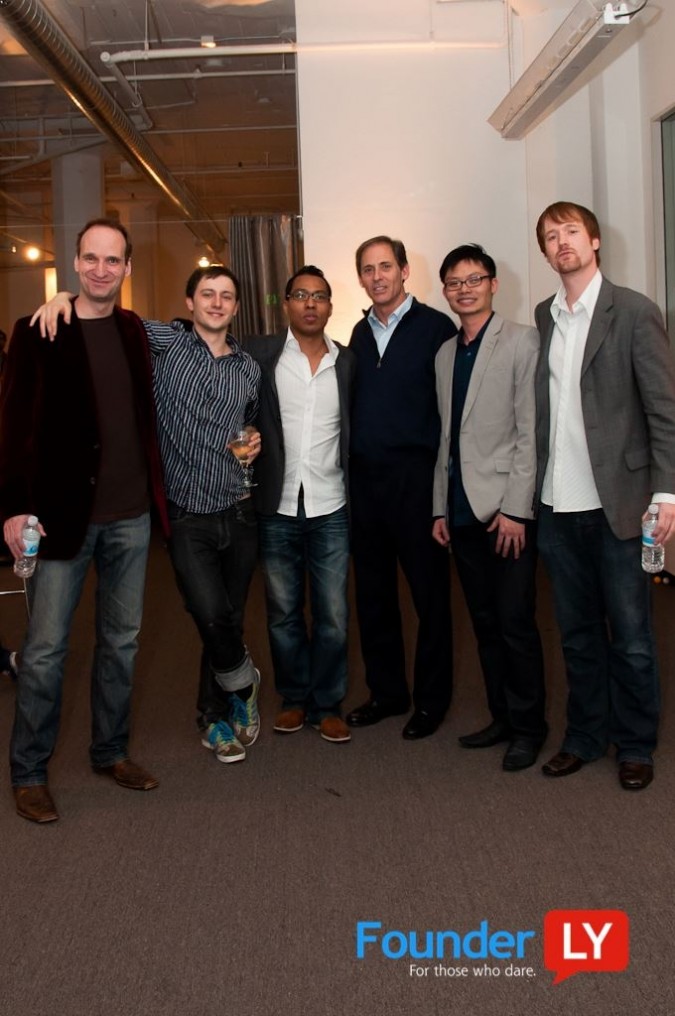
Kevin Warnock, Ilya Zhitomirskiy, Matthew Wise, Grant Ricketts, ___ and Andreas Sæbjørnsen, March 3, 2011
Last Friday, November 18, 2011, I attended a memorial service for Ilya Zhitomirskiy. I wrote a blog post about the service.
In that post I mentioned I had met Zhitomirskiy once, at a party at the offices of CloudFlare, the red hot website performance and security startup that just won the Wall Street Journal’s Innovation Award in the Network and Internet Technologies category. After my memorial post, a friend of mine that read the post sent me the above photograph from that party. As you can see, I’m standing there on the left next to Zhitomirskiy.
I just had to post the picture here because it’s such a great picture.
My friends Matthew Wise, Grant Ricketts and Andreas Sæbjørnsen are also in the picture.
I will attend CloudBeat 2011, a cloud computing conference organized by VentureBeat
I plan to attend CloudBeat 2011 in Redwood City, California USA on November 30th and December 1st, 2011.
CloudBeat is an event put on by the website VentureBeat.
Since I’m in the process of moving the infrastructure for my company’s website to the cloud, I thought it would be a great idea to attend and make some new friends. If you’re also going to be there and would like to say hello, send me a message on Facebook, here.
I’ll be blogging about the event, so look for a report here.
My grandmother Elsie Battaglia’s 100th birthday party coming up December 12, 2011
Yesterday, November 21, 2011, I received a paper invitation from my beloved 99 year old grandmother Elsie Battaglia to her 100th birthday party, which is scheduled for December 12, 2011, next month. I scanned the invitation for you to see. I direct your attention to left side of the graphic, which is the front of the invitation. The right side of the graphic is the interior of the folded invitation.
The text on the left illustrates the strides the world has made in the last 100 years.
I love my grandmother Elsie so much. I’ll be at her birthday party, and I’ll share the highlights with my readers here on my blog.
If you’re having trouble reading the text, click on the invitation graphic to enlarge it dramatically.
Elsie is on Facebook. She had WebTV in 1997. Her now disabled and unused email address was elsie97@webtv.com. She had her Volkswagon Bug in the mid 1950s. Her first son (my father) picked it up for her in Paris, France and had it shipped back to Portland, Oregon, where no doubt it was one of the first in the United States.
